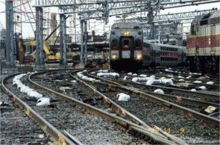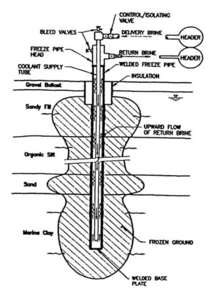Ground freezing


Ground freezing is a construction technique used in circumstances where soil needs to be stabilized so it will not collapse next to excavations, or to prevent contaminates spilled into soil from being leached away.[1] Ground freezing has been used for at least one hundred years.
Pipes are run through the soil to be frozen, and then refrigerants are run through the pipes, freezing the soil.[1] Frozen soil can be as hard as concrete.
Soil contaminated with radioactive elements that leaked from Japan's Fukushima Daiichi nuclear power plant was contained through ground freezing.[1]
Boston's big dig used ground freezing during some of its tunneling, to allow its wide tunnels to be built under or through soil that supported existing infrastructure that would have been difficult or expensive to support using more traditional excavation methods.[1]
Some ground freezing projects use common salt brine as the refrigerant.[2] But other projects benefit from using more exotic refrigerants, like liquid nitrogen.[1][3]
References
- ↑ 1.0 1.1 1.2 1.3 1.4 Jessica Morrison (2013-10-30). "How Engineers Use Ground Freezing to Build Bigger, Safer, and Deeper". PBS. Archived from the original on 2014-04-11. Retrieved 2014-07-22.
The basic premise behind ground freezing is that soil—made up of bits of minerals and organic matter, water, and air—becomes stronger and less penetrable when its water freezes and expands.
- ↑ "Technical Manual for Design and Construction of Road Tunnels - Civil Elements". US Department of Transport. Archived from the original on 2013-12-05. Retrieved 2014-07-22.
In order to maintain support to the tunnel face, excavation and jacking normally carried out alternately in small increments, typically in the range of 2 to 4 feet. In most cases, the soft ground must be treated by means of ground improvement techniques such as ground freezing, jet grouting, etc. as discussed in Chapter 7 Soft Ground Tunneling to enhance its stand up time.
- ↑ "Ground Freezing: Freezing soil with liquid nitrogen". The Linde Group. 2014. Archived from the original on 2014-02-26. Retrieved 2014-07-22.
During the last two decades soil freezing with liquid nitrogen (LIN) has developed from an exotic gas application with lots of uncertainties into a standard procedure for treating unstable soil and leakages.